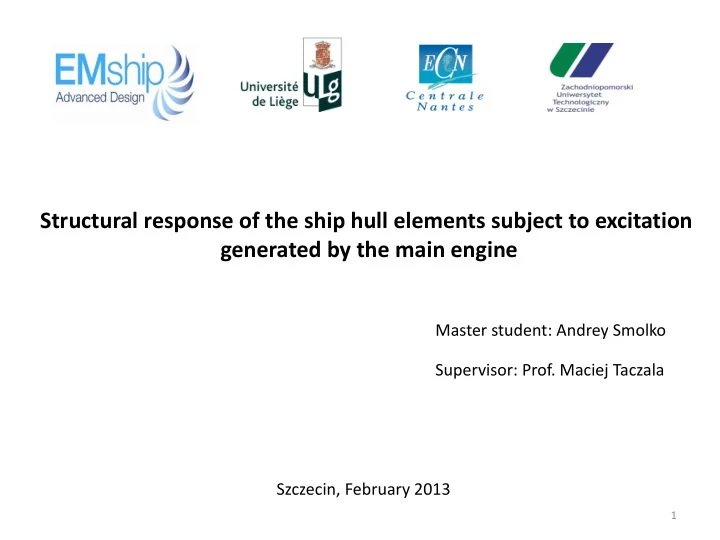

Structural response of the ship hull elements subject to excitation generated by the main engine Master student: Andrey Smolko Supervisor: Prof. Maciej Taczala Szczecin, February 2013 1
Ship excitation forces 2
Classification of a diesel engine exciting forces • Unbalanced forces or unbalanced moments induced by inertia forces due to the movement pistons, etc. • Guide forces or guide moments which are generated by combustion pressure of gas • Longitudinal exciting force which is induced by the inertia force of longitudinal deflection on the crankshaft due to gas pressure. • Fluctuation in thrust force which comes from torque variation in line shaft 3
Natural frequency ranges in shipbuilding application 4
Global structures 5
Relation ship between the exciting forces and responses 6
Global vibration modes in the case of excitation by the main engine The first order (1.5 Hz) excites the fundamental torsion vibration mode of the ship hull The vertical second order (3 Hz) mass moment Causes four-node vertical bending vibrations Of the ship hull 7
Engine/foundation substructures Slow-running diesel engine – three fundamental modes 8
Bulk carrier “Miedwie” case study Main engine Wartsila/Sulzer RTA48T-B 9
Vibration problem on board Problems: -High level vibration in the engine room when engine running with reduced speed (80-90 Hz) -Fatigue crack along welded joint - ‘Rocking’ lateral vibration Lateral side friction side stays 10
Analysis Scheme Structural response Forced linear vibration analysis: FE model preparation Modal analysis 1. Without side stays 2.With side stays Excitation forces 11
FE model preparation Submodels : • Hull structure • Electrical generators • Main diesel engine • Turbocharging system • Shaft line • Superstructure 12
Hull structure (I) 13
Hull structure (II) platform 11100 14
Hull structure (III) platform 7000 15
Hull structure (III) doublebottom structure 16
Electrical generator set positions 3 generators – total weight 50.5 tones 17
FE representation Geometrical models FE models 18
Main engine - 6RTA48T-B - Crosshead 19
FE model of the main engine 20
Engine platforms 21
FE model of shaft line 22
Superstructure representation 23
Modal analysis Boundary conditions – no translation degrees of freedom 24
Modal analysis without side stays 25
Calculated natural frequencies • 4.97 Hz - vertical • 5.89 Hz – H-type • 6.53 Hz - vertical • 6.92 Hz – H-type • 7.15 Hz – H-type • 9.3 Hz – X-type • 9.52 Hz – L-type • 9.53 Hz – L-type 26
5.89 Hz – H-type 27
6.92 Hz – H-type 7.15 Hz – H-type
Modal analysis of the rigid engine on the elastic foundation E=1e+013 Pa Four H-type modes: 9.18 Hz 9.46 Hz 9.52 Hz 9.55 Hz Shift is 2-2.5 Hz 29
Modal analysis of the engine structure on the rigid foundation 30
H-type 8.55 Hz X-type 12.95 Hz 31
Forced vibration analysis 6 th order frequency 32
Lateral guide forces 33
Results without side stays configuration Position of a central node 34
35
Analysis of the forced engine vibration with installed side stay 36
Modified FE model 37
Results of the simulation 38
Stress field 39
H-type mode 40
Conclusions Solutions: • Installation of the friction side stay was incorrect (too tight) and it caused resonance effect. Proper friction force adjustment may reduce high vibration level. • Eliminate stress concentrators Potential solutions: • Hydraulic stays • Modification of engine foundation 41
42
Recommend
More recommend